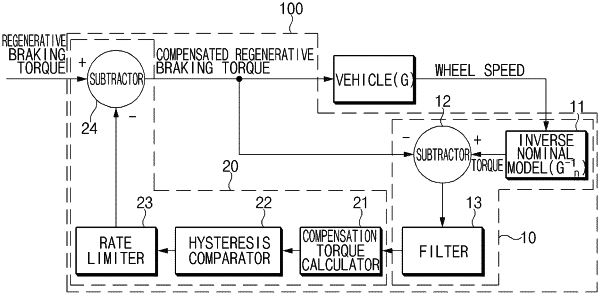| CPC B60L 7/18 (2013.01) [B60L 3/108 (2013.01); B60L 15/2009 (2013.01); B60L 2240/423 (2013.01); B60T 2270/602 (2013.01)] | 10 Claims |

|
1. An apparatus for controlling a regenerative braking torque of an electric vehicle on which an anti-lock brake system (ABS) is mounted, the apparatus comprising:
a processor; and
a non-transitory storage medium containing program instructions that, when executed by the processor, causes the apparatus to implement
a disturbance extractor to extract a disturbance in a specific frequency band from a difference between a torque output based on a model behavior represented by an inverse nominal model in a form of a transfer function that outputs the torque when a wheel speed is input, and the regenerative braking torque based on an actual behavior of the electric vehicle while moving, and
a torque compensator to compensate for the regenerative braking torque based on the disturbance extracted by the disturbance extractor to prevent an operation of the ABS while the electric vehicle is moving to maximize an energy recovery rate by a motor of the electric vehicle via regenerative braking by calculating a compensation torque to offset the disturbance extracted by the disturbance extractor, and subtracting the compensation torque from the regenerative braking torque,
wherein the program instructions, when executed by the processor, further cause the torque compensator to set a changing rate of the compensation torque, and
wherein the changing rate of the compensation torque is set by
equally dividing and applying the compensation torque by increments within a reference time when the regenerative braking torque is increased, and
applying all of the compensation torque within the reference time when the regenerative braking torque is decreased.
|